#w.j.t. mitchell
Text

"The Last Thunder Horse West of the Mississippi," 1998, by Bob Walters
Cover art for Isaac Asimov's Science Fiction Magazine, 1998 and for The Last Dinosaur Book: The Life and Times of a Cultural Icon by W.J.T. Mitchell, University of Chicago Press, 1998.
225 notes
·
View notes
Note
I can never get over how personal it must be for Satoru to reveal his eyes.
I study visual culture as part of my degree, and so, for me, the dynamic of who sees who and how is something that I constantly grapple with.
And so, when it comes to Satoru, what I constantly think about is the fact that his shades and his blindfold block others from seeing him while he can see others, thus creating a situation of 'seeing without being seen'.1
I know it's a tiny detail, but I just find it so fascinating and so I imagine that the act of truly seeing his eyes is so personal and intimate for both parties.
2. W.J.T. Mitchell, ‘Showing Seeing: A Critique of Visual Culture’, in The Visual Culture Reader, second edition, ed. Nicholas Mirzoeff. Routledge, Taylor & Francis Group: London and New York, 2002, 86–101.
oh my god yes!! the fact his eye covers get more extreme as time progresses (sunglasses -> bandages -> blindfold), shows how more and more he’s closing himself off from the world. because yes emotion is contained all over our faces but our eyes are the most expressive part of us. it’s literally the gateway to the soul, and it makes so much sense that when geto is gone and he’s the strongest that he’s closed his soul off increasingly.
also I wanna read the article you linked omg
#sab [anons]#sab [asks]#sab [jjk meta]#I know I keep making tags but I wanna be able to find these things
25 notes
·
View notes
Text
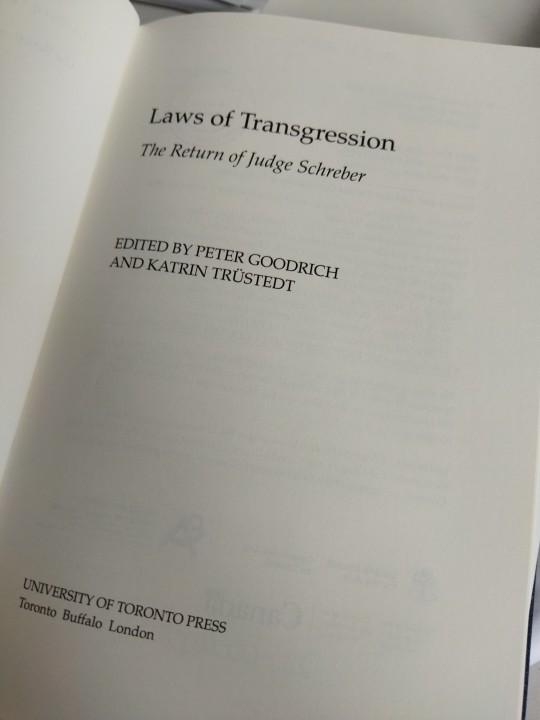
Was ist Ikonologie?
1.
Noch einmal, aber nur zur Wiederholung:
Ikonologie ist gepflegte Paranoia und sanft schizoid. Man sieht in jedem Bild ein Vorbild und ein Nachbild. Der Ikonologe geht erstens davon aus , dass nichts in der Welt von selbst mit nichts verbunden ist und das zweitens nichts in der Welt von selbst mit allem verbunden ist.
Durch Assoziationen kann es Verbindungen geben, die dann bildlich, logisch und graphisch, also auch künstlich und rational oder technisch sind. Ikonologie ist eine Wissenschaft von Referenzen, also eine Normwissenschaft. Sie ist eine Wissenschaft von Symbolen, also von Distanzschaffen, Entfernung, Trennung und Austauschmanövern. Eine ikonologische Rechtswissenschaft kann, muss aber keine Wissenschaft visueller Medien, nicht eine Wissenschaft der Visualität sein, weil es die bildliche Assoziation auch in nicht-visuellen-Medien gibt. Eine ikonologische Rechtswissenschaft sollte Aby Warburg in Rechnung stellen, also kalkulieren, ob und inwieweit normative, juristische, juridische Reproduktion auch eine Artikulation des sog. Nachlebens ist.
2.
Eine ikonologische Rchtswissenschaft ist auch ein Wissenschaft symptomatischer Normativität, auch eine Wissenschaft der Polarität und des Schizoiden, einer Mimesis, die über Exzesse und Ekstasen vielleicht noch rekursiv operiert, vielleicht involvierend und revolvierend bleibt, die aber Referenzen aufschichtet und abschichtet und dadurch jeder Referenz die Möglichkeit nimmt, sich zu einer großen, zentralen Referenz aufzubauen und zu halten.
3.
Katrin Trüstedt und Peter Goodrich haben sich einer Kehre, der Wiederkehr des Richters Schreber angenommen. Sie haben zusammen einen äußerst lesenswerten, anregunsreichen Sammelband herausgegeben, mit Aufsätzen von Werner Gephart über Schrebers Fall und die Flucht vom rationalen Recht, von Mark Sanders über die Primal Scene, von Rajgopal Saikumar über Das Amt des Genusses/ Schrebers kleine/mindere Jurisprudenz, von Kathrin Trüstedt über Schrebers doppelten Prozess: rechtliche und literarische Verfahren in Schrebers Erinnerungen, von Ludwig Schmitz über Adressen ohne Signaturen/ Schrebers Erinnerungen und die Manning-Lamo Chat Logs, von Daniela Gandorfer über Gedanken, die es lohnen gedacht zu werden, von Patricia Gherovici über Schrebers Grande Bellezza, von W.J.T. Mitchell über begabte Schizophrenie und schließlich von Davide Tarizzo über die wahnhafte Metapher/ Schrebers Anathema.
Wie man sieht: Viel zu lesen, viel Futter, viel Anregungen für alle.
4.
Der Bildwissenschaftler W.J.T. Mitchell erwähnt in seinem Aufsatz gleich am Anfang Aby Warburg, weil der zu einer Gruppe begabter Schizophrener gehört habe. Er stellt gleich am Anfang eine Verbindung zu demjenigen her, den ich nicht nur für jemanden halte, der wie aus der Kunstgeschichte ausgestiegen erscheint und der dazu noch so scheint, als ob er Vater einer Kulturwissenschaft und Bildwissenschaft sei. Ich halte Warburg auch für einen Polarforscher und Rechtswissenschaftler. In nachdrücklichem Sinne ist Warburg ein Zeitgenosse schließlich Schrebers, das liegt wegen dieses nachdrücklichen Sinnes von Zeitgenossenschaft nicht daran, dass beide zur gleichen Zeit gelebt hätten, sondern daran, dass sie in der Zeit und durch Zeit eine Zeit teilen konnten.
Dass dieser Aufsatz zu Gesetzen der Transgression und zu einem historischen Richter von einen Bildwissenschaftler stammt und dort am Anfang Aby Warburg auftaucht, ist nicht der Grund, warum ich zuerst diesen Aufsatz hier 'verzettele'. Das liegt daran, dass Mitchell ebenfalls als Polarforscher darüber schreibt, als jemand, der dem Wissen um die Polarität/ Ambivalenz der Schizophrenie ausgesetzt war, und dass er von dort aus versucht, erstens Schizophrenie als Technik zu rekonstruieren und zweitens das Symptom nicht zu privatisieren.
Don't let your passion be privatized, das wäre wohl ein/ das Motto für Polarforscher. Mitchells Sohn Gabriel überlebt die Schizophrenie, die im Alter von 21 Jahren diagnostiziert wurde, bis er im Alter von 38 Jahren Selbstmord begann. Mitchell kennt die Schatten, die Dämonen, das Monströse, das Bösartige, den Fluch und das Verfolgende der Schizophrenie, und doch nimmt sein Text den Ausgangspunkt in einer Gabe/ einer Begabung, in der das Dogma der Großen Trennung in der Form nach dem Wahn der Größe entspricht. Mitchell Text führt an einem Scheitelpunkt an eine Frage nach der Verwechslung heran, die auch für eine ikonologische Rechtswissenschaft eine der zentralen Fragen ist. Dass Verbindlichkeit (nur) eine Assoziation ist, klingt sonst nicht unbedingt als Herausforderung, hier aber doch.
2 notes
·
View notes
Text
Reading Report, Research Report
The 2 extracts chosen are from an essay from a book called ‘Landscape and Power’ by W.J.T. Mitchell which was published in 1994 by the University of Chicago. William John Thomas Mitchell is an American Academic, He was born in March 1942 and he is known for the Development of a picture theory within the field of visual culture and digital media research, Looking at the study of images across the media. This book helps to understand the ideas of Landscapes across cultures as well as Landscape identities.One of the main themes within this book is the idea of Aesthetics e.g. The picturesque, The sublime. It also speaks of the Idea of picturesque and how that translates across to identities.
When Relating this to my work, I thought due to this being about landscape and power as well as the identities which are created that this book and extracts from said book link well when trying to look more into the reasons why landscape and Humans are so interconnected.The Ideas of Landscape Identities “The concept ‘landscape identity’ builds on both place identity literature and landscape studies, developed through both theoretical exploration and practical development (Stobbelaar & Pedroli). Within landscape studies, landscape identity has traditionally been treated as the visual and physical character of the landscape (Krause, Nitavaska)” (Full article: Changing landscape identity—practice, plurality, and power (tandfonline.com)) Another concept is the idea that Landscapes strengthen The cultural and locational Identity that people feel. Locational Identity is an aspect that cannot be gotten rid of and is ingrained deep within our culture an example of this could be “When we meet someone new we often represent ourselves by mentioning the place we were born or where we have grown up, as well as we can mention our country or nationality” (
ResearchGate)
This book and research around it have also then taken me onto the topic of National Identity. The book Landscape and Power, Speaks of many things one being the idea that landscapes are more of a cultural element to identities they influence the identities of entire communities. The author of this book looked into reshaping the direction of landscape studies and to do this it was by considering landscape not simply as an object to be seen or a text to be read, but as an idea of cultural force, a method of creation of national and social identities. This book links to my project in means of locational identity as I am hoping to explore how people feel around certain landscapes and places. The Identity that is created by the place you are from, it is one of the aspects which are inalterable about us as people.
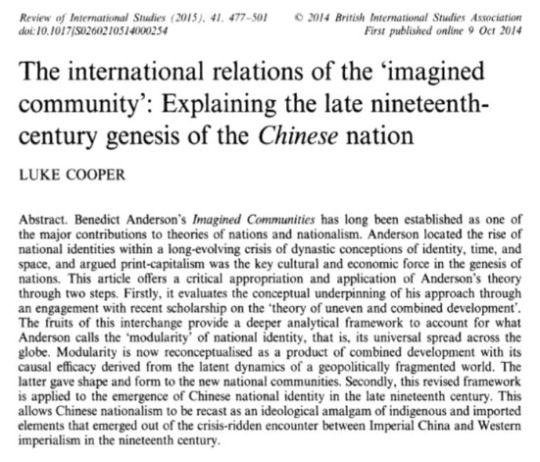
Figure 1, A passage from The International Relations of the Imagined Community, 2014
Whilst Researching the topic I came across a man called Benedict Anderson. There are many very Interesting elements written about him and the ‘Imagined Community’, which speaks largely about the idea of nations and nationalism. “Anderson argued that nationalism was a cultural artefact spontaneously created through the convergence of discrete historical forces at the end of the eighteenth century, and transplanted across the world because people became able to imagine themselves part of a community defined by nationality.” (https://www.bing.com/search?q=benedict+anderson+and+cultural+identity&FORM=HDRSC1 ) The idea of cultural Identity is often meaning the feeling of belonging, within a group they are often tied by thing such as “knowledge, beliefs, artefacts, arts, morals, and law” (Sustainability | Free Full-Text | The Role of Landscape Art in Cultural and National Identity: Chinese and European Comparisons (mdpi.com))
Connecting to the chosen text I guess I hope to look at the sublime, the extraordinary. Those aspects of nature simply have no explanation. The harmony is created through these paintings. Harmony is the visually satisfying effect of combining similar or related elements. Harmony in a painting or design helps bring about unity. All harmony and no contrast, however, can become monotonous. A balance must be struck between areas of harmony and areas of contrast.
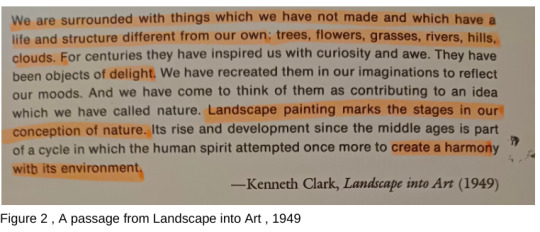
The extract above is taken from the book Landscape and Power, However by someone called Kenneth Clark and from a book entitled Landscape into art which was published in 1949. Kenneth Clark was an English Art Historian, Museum Director and Broadcaster. “Landscape Into Art a book that outlines the growth of landscape painting as an independent art, from the early use of symbols taken from nature to the canvases of such great painters as Constable and Corot, Turner and Van Gogh, Cezanne and Seurat.”(Landscape Into Art - Kenneth Clark - Google Books) “Landscape art began to gain prominence as an independent genre during the Renaissance, as artists focused more on the natural world and its beauty. The development of linear perspective and the increased emphasis on realism in art further contributed to the rise of landscape painting.” (A Journey Through Landscape Art History | Memorialize Art). The different styles of landscape paintings are very interesting the idea of places being romanticised as well as changed into images more spectacular than the actual scene interests me.
The ideas of contemporary landscape art, In contemporary art, landscape artists continue to push the boundaries of the genre by incorporating new media, techniques, and conceptual approaches. Environmental concerns, urbanisation, and cultural identity have emerged as prominent themes in modern landscape art, reflecting the evolving relationship between humans and nature. (A Journey Through Landscape Art History | Memorialize Art). Something else in this reading I find particularly interesting from the book entitled Landscape and Power is that the medium of landscapes can be found in all cultures. The idea is that we are surrounded by things, not human e.g. trees, flowers, grasses, rivers, hills, and clouds. These things have been the center of interest for centuries, and they are also the elements that make up our landscapes. The cultural identity that nature and the Landscapes provide us. An example of this is “The depiction of landscape in art has played a major role in the creation of cultural identities in both China and Europe. Landscape depiction has a history of over 1000 years in China, whilst in Europe its evolution has been more recent.” (Sustainability | Free Full-Text | The Role of Landscape Art in Cultural and National Identity: Chinese and European Comparisons (mdpi.com)).
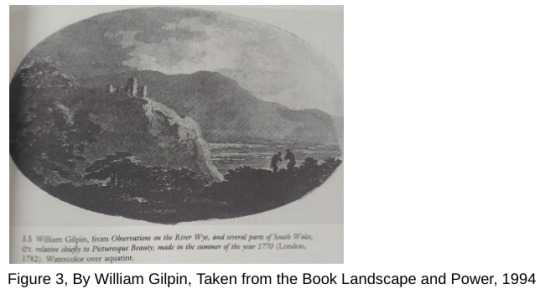

The Idea of the Picturesque, A form of aesthetic which was first started in 1782 by an English Cultural Debate by William Gilpin. William Gilpin is an English Writer, Printmaker, Clergyman and Schoolmaster who died in 1804 (William Gilpin, Creator of the Picturesque: Paintings & Biography | Study.com). In 1768 Gilpin published his popular Essay on Prints where he defined the picturesque as “that kind of beauty which is agreeable in a picture” and began to expound his “principles of picturesque beauty”, based largely on his knowledge of landscape painting. (William Gilpin | Artist | Royal Academy of Arts).
The piece seen in Figure 4 was from sailing down the River Wye. To allow “viewers to visualise his descriptions of Landscapes Gilpin illustrated his tours with aquatint landscapes”. These picturesque landscape pieces were however disliked as people said when they went to visit these landscapes they did not correspond to the places that were actually there. (Landscape and Power, pg 87). Since then many places have written about the idea of the Picturesque, I particularly like what was written by the National Trust as it speaks of the picturesque scenery of the lake district which I previously looked at Alfred Wainwright in my artist's research report as he looked and studied the Lake District in Sketches and Maps, “Gilpin published guidebooks to picturesque destinations such as the Wye Valley and the Lake District, and essays explaining how to sketch picturesque scenery. Poetry describing specific landscapes and coffee-table books filled with prints were also popular means of experiencing the picturesque.” (What is the picturesque? | National Trust )
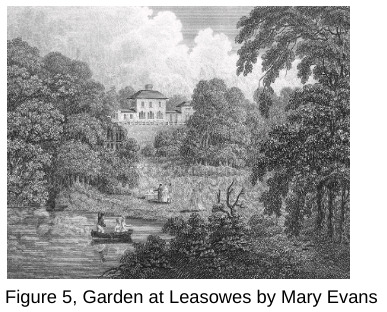
After reading the section from Landscape and power which explores the Picturesque, I found that often vast landscapes create ideas of the ideal. Often far from the reality of what they actually are however I think that is one of the many reasons why they are so interesting. The idea of images being translated into art or text often don't always translate in the most realistic or honest ways. “The Picturesque was not just a style. It was an aesthetic category applied across painting, architecture, landscaping, music, and literature, propagated in England.” (Planning the Picturesque — Google Arts & Culture) The image seen in figure 5 is known for being the first image to represent English picturesque landscape movement with examples of the “wooded valleys, open grassland, lakes, streams all of which are typical features of the picturesque”
To conclude I think that starting with the book Landscape and Power has encouraged research into many different directions which has led to me then finding a variety of new artists which have been very influential.
Bibliography
Anon, (n.d.). Picturesque. [online] Available at: https://afragilecorrespondence.org/picturesque/ [Accessed 18 Feb. 2024].
Artsper Magazine. (2021). A Brief History of Landscape Art, from the Renaissance to contemporary art. [online] Available at: https://blog.artsper.com/en/a-closer-look/a-brief-history-of-landscape-art-and-painting/.
Butler, A. and Sarlöv-Herlin, I. (2019). Changing landscape identity—practice, plurality, and power. Landscape Research, 44(3), pp.271–277. doi:https://doi.org/10.1080/01426397.2019.1589774.
Caddia, L. (2011). Behind and Beyond, the Picturesque Still Lives. Art History, 34(3), pp.615–618. doi:https://doi.org/10.1111/j.1467-8365.2011.00831.x.
Clark, K. (1976). Landscape Into Art. [online] Google Books. J. Murray. Available at: https://books.google.co.uk/books/about/Landscape_Into_Art.html?id=CdBXMQAACAAJ&redir_esc=y#:~:text=Landscape%20Into%20Art%20Kenneth%20Clark%20J.%20Murray%2C%201976 [Accessed 18 Feb. 2024].
Fay, J. (n.d.). What is the picturesque? [online] National Trust. Available at: https://www.nationaltrust.org.uk/discover/history/gardens-landscapes/what-is-the-picturesque.
Google Arts & Culture. (n.d.). Planning the Picturesque. [online] Available at: https://artsandculture.google.com/story/planning-the-picturesque-royal-institute-of-british-architects/YgVRY55xn-MzYw?hl=en# [Accessed 18 Feb. 2024].
İlke Hiçsönmezler and Fatma İpek Ek (2023). Picturesque atmosphere: in-between the past and present. Studies in the History of Gardens & Designed Landscapes, 43(3), pp.188–207. doi:https://doi.org/10.1080/14601176.2023.2282196.
Macarthur, J. ( March 2013). The picturesque: Architecture, disgust and other irregularities. [online] Research Gate. Available at: https://www.researchgate.net/publication/288433033_The_picturesque_Architecture_disgust_and_other_irregularities [Accessed 18 Feb. 2024].
Mambrol, N. (2021, February 16). The Sublime. Literary Theory and Criticism. https://literariness.org/2021/02/16/the-sublime/#:~:text=The%20sublime%20is%20a%20central%20category%20of%20aesthetics
Memorialize. (2024). A Journey Through Landscape Art History. [online] Available at: https://memorialize.art/blogs/news/a-journey-through-landscape-art-history#:~:text=Landscape%20art%20began%20to%20gain%20prominence%20as%20an [Accessed 18 Feb. 2024].
Mitchell, W.J.T. (1994) Landscape and power. Chicago ; University of Chicago Press.
Study.com. (2019). William Gilpin, Creator of the Picturesque: Paintings & Biography | Study.com. [online] Available at: https://study.com/academy/lesson/william-gilpin-creator-of-the-picturesque-paintings-biography.html.
Royalacademy.org.uk. (2019). William Gilpin | Artist | Royal Academy of Arts. [online] Available at: https://www.royalacademy.org.uk/art-artists/name/william-gilpin.
Tate (2017). Picturesque – Art Term | Tate. [online] Tate. Available at: https://www.tate.org.uk/art/art-terms/p/picturesque.
the Guardian. (2016). The cult of the picturesque view ignores the reality of modern Britain. [online] Available at: https://www.theguardian.com/artanddesign/jonathanjonesblog/2016/dec/07/the-cult-of-the-picturesque-ignores-the-reality-of-modern-britain [Accessed 18 Feb. 2024].
uag.arts.uci.edu. (n.d.). The Symbolic Landscape: Pictures Beyond the Picturesque | University Art Galleries | Department of Art | Claire Trevor School of the Arts. [online] Available at: https://uag.arts.uci.edu/exhibit/symbolic-landscape-pictures-beyond-picturesque [Accessed 18 Feb. 2024].
Wen, X. and White, P. (2020). The Role of Landscape Art in Cultural and National Identity: Chinese and European Comparisons. Sustainability, [online] 12(13), p.5472. doi:https://doi.org/10.3390/su12135472.
0 notes
Text
Art and feminism, a conversation with modernism in the age of contemporary art.
The age of modernism brought to the fore a revolution in the art making process. It opened doors to the different possibilities in which we interpret and consume art but most importantly, its contributions brought forth an evolution that continues to influence the work of contemporary artists today. As we attempt to find meaning and explore the notion of what art can be within present-day society, there are many key elements within modernism that may be readily denoted in a contemporary artist’s work. When we analyze Barbara Kruger’s work, the key components in modernism become apparent, thereby making the work significant in the age of contemporary art.
The women’s liberation movement began in the 1970s simultaneous with the civil rights movement. Feminist art was on the rise and many emerging female artists began making self-described feminist art. During the early 70s, Kruger was making artwork using textiles such as weaving and painting—materials that would be classified as craft and would be subsumed within the category of the feminine. She later decided to abandon this aesthetic because she felt it had no significant impact or meaning and consequently stopped making art to then teach at the University of California in Berkley. [1] In 1977, moving away from her previous aesthetic, she began making the work we now know today. [1]
Barbara Kruger was born in Newark, New Jersey in 1945 and studied at Syracuse University and Parsons School of Design; however, her education was brief and she later began to work as a graphic designer for a publications company at Mademoiselle magazine. [1] This was her initial encounter with image and text which served as the pivotal turning point for her work. Furthermore, her background is equally important in the way we understand her art because it has influenced and set the foundation for her image-making process. Kruger is an important artist to the feminist art movement for the reason that her work is deeply rooted in challenging societal norms. Her gender-address invites the viewers' active participation and critical analysis to reinterpret appropriated images juxtaposed with seemingly hostile text. Her work provokes the questioning of the media’s role within society as well as how we consume art. Yet most importantly because of the nature of experimenting with different environments and methods of delivery, it also challenges previously held notions established by the art mecca institutions we know today.
Understanding through play
Few have been able to accomplish what Kruger accomplished in her work. Much of the feminist artwork emerging from the 70s tended to have biased opinions on the notion of a woman’s role in society and for the most part approached the subject matter less objectively and more on the basis of feelings. [7] Their work tended to gravitate more towards emotion and less on philosophical and anthropological grounding, therefore, detracting from the ability to reestablish some credit as to the redefining of gender roles and the importance of women as artists in society be it in a historical or contemporary context. [7] In an interview with W.J.T. Mitchell, Kruger repeatedly brings up her disinterest in the binary, of taking a stance against or for an ideology. [3] Additionally, her interests remain in questioning and challenging the viewer by bringing doubt rather than answering questions. [6] Kruger does not believe in the categorization of groups such as feminist art or black art, she’s interested in opening and liberating debate to create new ways of understanding and meaning. [6] Kruger is taking a position and forming a new ideology which does assimilate to the current patterns of art making and notions of feminism. This is a new approach and aesthetic, was innovative of its time and can be very well considered avant-garde.
It is not difficult to decipher meaning in Kruger’s work. As her work is explicit but not direct, it has a “distance in speech.” This requires the viewer's active participation and critical analysis. [2] Her work challenges not only the viewer with regards to the status quo but also the art institutions in relation to its traditional methods of art making, analysis and philosophical debate. Some of her work can be exhibited in galleries, others on printed media or installed in outside public spaces such as billboards. Kruger challenges the way we consume art and plays with different outlets outside of the institutions which have been dictating art consumption for years. Furthermore, by utilizing different outlets for exhibition, the work itself takes on another important element: the mainstream outlets of consumption. Kruger is using advertisement’s language to create new forms of communication. Ready-made or, rather, appropriated images in combination with antagonistic text, recontextualizes the image’s initial intended purpose, namely the continued perpetuation of the female role in society. However, this new form of communication takes on a gender-address which is ultimately feminist and which consequently questions the dominant patriarchal view of the time. [2]
Appropriation in modernism is very prevalent as artists come up with new aesthetics for redefining art. The question remains on the ethicality of such practices and Kruger seems to have experienced legal issues with her collage It’s a small world but not if you have to clean it (1990). In 2000, Kruger and the Museum of Contemporary Art in Los Angeles was sued by German photography Thomas Hoepker and Charlotte Dabney on account of copyright violation and violation of privacy for using Hoepker’s 1960 image Charlotte. [4] The case was dismissed because Hoepker never filed for U.S. copyright and two years after the copyright ran out, Kruger created the work. [4] Hoepker never asked Kruger to remove the image prior to filing suit and therefore, had no recourse toward gaining favor with the courts. [4] Conversely, Kruger as well as artists that came before, such as Duchamp (who is primarily credited for the culture of appropriation), have been incorporating this aesthetic in their work. Overall, the redefining and recontextualizing of the image makes it new but it’s questionable whether the appropriate course of action may be to obtain permission from the original artist or copyright owner. To add further, Kruger had no comments regarding the dispute. [4]
On the rise
Kruger’s work is currently in the collection of the Museum of the Modern Art in New York, Tate in London, the Centre Pompidou in Paris, as well as in other international and domestic institutions. [5] In 1973, she exhibited work in the Whitney Biennial and had solo exhibition shows at John Doyle Gallery in Chicago in 1976 and in 1979 at the Franklin Furnace Archive in New York. [5] In the 1980s, through the Public Art Funds as part of the “Messages to the Public” series, she was able to create public artworks such as in New York’s Time Square where a digital billboard displayed messages such as “I’m not trying to sell you anything” and “I just want you to think about what you see when you watch the news on t.v.” [5] In 1988, a billboard was installed in Brooklyn with the message “We don’t need another hero.” [5] On a side note, in an interview with W.J.T. Mitchell, Kruger was asked regarding the latter piece and the fact that it had printed along the bottom of the billboard “A Foster and Kleiser Public Message.” To which she responded that they just put that on the billboard and that she was happy that it was there because “it in fact puts these words in the mouths of this corporate group which she thinks is great! To see that sort of enterprise saying ‘we don’t need another hero’ is terrific!” [3] Additionally, from 1999-2000 she had a mid-career retrospective that traveled from the Museum of Contemporary Art in Los Angeles to the Whitney Museum in New York. [5] In 2002, as part of the Schirn Kunsthalle’s exhibition “Shopping: A Century of Art and Consumer Culture,” her work “Untitled (Shopping)” covered the front of the Kaufhof Department Store with the German words “You want it. You buy it. You Forget It.” [5] In an interview with Schirn, Kruger mentions that the biggest installation she’s ever done is Frankfurt because it was the only place there could have been a collaboration between a museum, the city, and a department store and that she couldn’t see that happening anywhere else and in that scale. [6]
youtube
In retrospect
In the 1971 essay “Why Have There Been No Great Woman Artists” Linda Nochlin, states that the feminist movement of the time must come to “grips with the intellectual and ideological basis of various intellectual or scholarly disciplines—history, philosophy, sociology, psychology, etc.—in the same way that it questions the ideologies of present social institutions.” She further elaborates that the current movement is based on subjective and emotional needs, consequently failing to address the issues which the movement brings forth. [7] Taking into consideration Kruger’s work, it becomes apparent that she breaks through this emerging feminist art of the time by attempting to open debate with the current socio-political issues. The work confronts the viewer by challenging and bringing awareness to the issues at hand. Furthermore, by assimilating the aesthetic and characteristic methods of media and advertisement, Kruger is creating the opportunity for the progression and continuation of an open discussion.
Clement Greenberg’s essay “Modernist Painting,” states that “the essence of Modernism lies, as I see it, in the use of characteristic methods of a discipline to criticize the discipline itself, not in order to subvert it but in order to entrench it more firmly in its area of competence.” [8] Moreover, in an interview with W.J.T. Mitchell, Kruger was asked if the “word-image composite” known to the advertisement and commercial domain would make it possible for a new public art given that modernism set the tone in the current state of public art where its “unreadability” makes it far removed from public understanding and instead stands as a “private symbol.” [3] Kruger agreed and proceeded to mentioned that through image and text we have learned and developed a language of understanding which derived from advertisement and technological advancement in the fields of photography, film, and video. [3] However, although there’s a common language, it’s still not the same as creating meaning. In fact, Kruger states it does the opposite. [3]
“Although we are always hearing about access to information, more cable stations than ever…. But it’s not about the specificity of information, about notions of history, about how life was lived, or even how it’s lived. It’s about another kind of space. It’s as Baudrillard has said, ‘the space of fascination,’ rather than the space of reading. ‘Fascinating’ in the way that Barthes says that stupidity is fascinating. It’s this sort of incredible moment which sort of rivets us through its constancy, through its unreadability because it’s not made to be read or seen, or really it’s made to be seen but not watched. I think that we can use the fluency of that form [television] and its ability to ingratiate, but perhaps also try to create meanings, too. Not just re-create the spectacle formally, but to take the formalities of the spectacle and put some meaning into it. Not just make a statement about the dispersion of meaning, but making it meaningful” [3]
Kruger uses her skills as a graphic designer to explore the possibilities of what image and text can accomplish, however, she is not interested in dissolving meaning as most modernist tend to gravitate toward, she’s interested in creating meaning though her work. She criticizes the discipline itself by making her work on printed materials, for display in a museum, film, photography, and outside public structures but most importantly by creating meaning.
In Summary, modernism influenced Barbara Kruger’s aesthetic in its approach to image and text. Her gender-address through the appropriation of images juxtaposed with confrontational text, created a new language which encourages the active viewer to engage in critical thinking about the context being presented. Furthermore, her work not only challenges the way we consume art but also the media and our current socio-political climate. Kruger’s work has received critical acclaim being exhibited in very important landmarks and institutions making her an artist of our times. Additionally, her interest in creating meaning within her work liberates and opens discourse on ideological and philosophical issues which have stifled our society throughout the years.
References
1. “Barbara Kruger.” The Board. https://www.thebroad.org/art/barbara-kruger
2. Kamimura, Masako. “Barbara Kruger: Art of Representation.” Woman’s Art Journal, vol. 8, no. 1, 1987, pp. 40–43. JSTOR, https://doi.org/10.2307/1358339. Accessed 27 Aug. 2022
3. Mitchell, W. J. T., and Barbara Kruger. “An Interview with Barbara Kruger.” Critical Inquiry, vol. 17, no. 2, 1991, pp. 434–48. JSTOR, http://www.jstor.org/stable/1343844. Accessed 29 Aug. 2022.
4. “The Kruger Controversy: Court Throws out Lawsuit against Barbara Kruger, Clarifies Copyright Law.” Art on Paper, vol. 7, no. 2, 2002, pp. 26–26. JSTOR, http://www.jstor.org/stable/24559614. Accessed 9 Sep. 2022.
5. Selvin, Claire. “Barbara Kruger’s Strange, Alluring Text-Based Artworks: How the Artist Critiqued Advertisement and Rose to Fame.” ARTNews, August 6, 2020. https://www.artnews.com/feature/barbara-kruger-art-exhibitions-1202696145/
6. Schirn Kunsthalle Frankfurt. “Interview. Barbara Kruger.” YouTube. Dec. 23, 2010 https://www.youtube.com/watch?v=DP7hbDkJql8
7. Nochlin, Linda. “Why Have There Been No Great Women Artist?” ARTNews. January 1971.
8. Greenberg, Clement. Modernist Painting. Forum Lectures (Washington, D. C.: Voice of America), 1960. Arts Yearbook 4, 1961 (unrevised).
0 notes
Photo

🎤 New episode of @FutureFossilsPodcast on #AIArt! https://www.patreon.com/posts/195-i-art-panel-75834982 The smartest conversation I've had on this topic to date, and the show notes aggregate enough intelligent commentary on this issue to keep you preoccupied for months (at which point it will all still be relevant, in spite of the rapid developments in this area.) Enjoy! I don't often beg for shares but this one deserves as much attention as it can muster... ✨ About This Episode: This week we dig down as what W.J.T. Mitchell called “paleontologists of the present” to explore the ramifications of #AI on the #creative economy as lensed through two notorious #WilliamGibson quotes: “The future is already here, it’s just unevenly distributed” and “The street finds its own uses for things.” Joining me on the call are artists Evo Heyning, Micah Daigle, Jamie Curcio, Topher Sipes, and Julian Picaza — all of whom I hold in high esteem and all of whom are doing fascinating things both with A.I. tools and without them. I recommend this profound discussion for some refreshing sobriety in what has so far proven to be a totally crazy pants public discourse dominated by people who either submit unthinkingly to new technologies or run from them screaming without anchoring their perspectives in any kind of historical perspective whatsoever… Be sure to give this episode’s extensive show notes your careful attention, as I’ve collected here a whole semester’s worth of reading and listening materials on this and adjacent subjects with the goal of having a single master compendium to drop into public threads on these subjects whenever possible. #Midjourney #DALLE #ChatGPT #GPT #AIArtist #ArtBasel #ScienceFiction #DigitalArt #TechEthics #AIEthics #IPLaw https://www.instagram.com/p/CmFX_UMvzDu/?igshid=NGJjMDIxMWI=
#aiart#ai#creative#williamgibson#midjourney#dalle#chatgpt#gpt#aiartist#artbasel#sciencefiction#digitalart#techethics#aiethics#iplaw
0 notes
Text
Barney the purple dinosaur was the role of his life. Then came the haters.
New Post has been published on https://medianwire.com/barney-the-purple-dinosaur-was-the-role-of-his-life-then-came-the-haters/
Barney the purple dinosaur was the role of his life. Then came the haters.
“Barney & Friends” was a mainstay of daytime television in the early 1990s, making a star out of the title character: a purple anthropomorphic T. rex who extolled the virtues of love, kindness and cleaning up your toys.
The character was an avatar of goodness, endearing himself to countless young children around the world even as he sometimes grated on their beleaguered parents. He was inescapable.
But not everyone considered Barney a friend, a phenomenon at the heart of a new Peacock documentary series called “I Love You, You Hate Me.” (NBC News and Peacock are both owned and operated by NBCUniversal.)
The docuseries explores how, throughout the ‘90s and early 2000s, Barney turned into a cultural punching bag, the subject of disdain from adults and derision from kids desperate to disavow their childish pastimes. He was the Jar Jar Binks of kids’ TV.
School-age kids added violent lyrics to the “Barney & Friends” theme song. NBA great Charles Barkley beat up Barney in a “Saturday Night Live” sketch. Urban legends about the character’s dark secrets sprung up. The internet gave rise to new genres of anti-Barney humor that freely mixed winking irony with seemingly real rage.
“Barney is on the receiving end of more hostility than just about any other popular cultural icon I can think of,” the University of Chicago academic W.J.T. Mitchell wrote in 1998. “Parents admit to a cordial dislike of the saccharine saurian, and no self-respecting second-grader will admit to liking Barney.”
Bob West, a veteran performer who provided the voice for Barney from 1992 to 2000, recalls the production of “Barney & Friends” as a blissful experience that was sometimes shadowed by darker intrusions from the wider world, like a string of death threats he says he received via email.
In a phone interview last week, West (who appears in the docuseries) reflected on the success of “Barney & Friends” and offered a few theories on why Barney proved to be such a lightning rod. In his mind, the backlash was driven in part by kids trying hard to flex their “machismo.”
Thirty years after Barney first showed up on TV, however, West still believes that Barney’s friends outnumber his haters.
The conversation has been lightly edited for length and clarity.
NBC News: I’ve read that you started working as a voice performer in the late 1970s. How exactly did you wind up voicing Barney?
Bob West: I started doing commercial work and narration in 1979 or so. I put together the world’s looniest demo tape. I had done some costumed character work. I worked as a robot character called The Blaster for a hospital in the Dallas area.
My agent recommended me to Dennis DeShazer, who was one of the producers of “Barney & Friends.” I auditioned with a lot of other folks. Because of a fluke, they had started to build the costume before casting the voice. I was too tall for the costume. [The costume actor] David Voss, who was shorter than me, fit the costume while I got the voice. We just synced up together.
“Barney & Friends” was a genuine pop culture phenomenon. The show was ubiquitous when I was growing up in the ‘90s. What did it feel like to be at the center of such a big hit?
It was completely surreal. We were in the studio so often, and we really didn’t see a lot of the reaction to the show. But then we would go out and do personal appearances, and we’d have meet-and-greets with kids and parents. We’d get to see the love that was being poured out toward Barney, and that was just amazing.
When you show up at a shopping mall in Hartford, Connecticut, and the sidewalks are lined with parents and strollers, and you get inside, where you expect 600 people but there’s 6,000, that’ll bring you to the present. [Laughs.] It’s a pretty good indication the love was strong.
When did you first start to realize there was all this hatred swirling around the show, though?
I have been online since way before most people accessed the internet. I had heard about some internet groups that were out there doing this role-play thing where they were fighting Barney because he was evil and such. But that turned out to be all in good fun. They were really good at it. [Laughs.] I actually logged in and said hello. They were very receptive to me, very nice.
Every once in a while I’d go out in a Barney jacket and I’d hear, “Oh, I hate that show!” It was kind of sad, but you just have to laugh it off.
In the docuseries you say you received death threats around this time, which is horrible. Did you ever get a sense of the specific motivations behind the messages?
The specific motivation was growing up. The people who sent me those threats were all kids in middle school. They were doing the thing where they’re trying to throw off childhood and trying to be cool. I’m sure a lot of them were having emotional issues or maybe they were having trouble at home. There’s just no way to know.
But usually when people lash out like that, there’s something they’re dealing with. They’re hurting, and that’s the only way to know how to cope.
I actually responded to a lot of them — when I was still on AOL and it was cool to be on AOL — and most of them would write back and say, “Oh, I’m so sorry, I didn’t realize there was a real person that was going to answer.” I never heard back from some.
It’s really part of growing up, although I have to say that we seem to have amplified that phase of life in the United States. I don’t recall that kind of backlash happening in other countries. We would go to Ireland or wherever, and there were kids in the audience who were 12 years old, singing along. I think there might be a cultural difference.
What is it about American culture or the American psyche that fosters what you’re describing?
I think we have this focus on, and sometimes an obsession with, rugged individualism. I won’t go into an analysis of John Locke or anything. But there’s a kind of machismo that kids are encouraged to adopt when they’re growing up, and I think that is a big contributor.
I think consumerism is a big contributor, too, because a lot of kids are pressured to wear the coolest thing or buy the coolest toy, so that feeds into it. I think we’ve got some growing up to do as a society in terms of learning to live together and support each other, and to put the community before the individual.
If the show premiered today, do you think there would be a comparable backlash?
I think that’s very possible. I think that innocence is valued in different ways by different people. Barney will always have a place in education, in culture, in helping kids grow up feeling safe. Who knows how long this current wave of social and political clashing will continue?
Barney was loved by far more people than he was ever hated. It’s not a true statement to say that he was equally loved and hated. The millions and millions of people who watched the show … they loved it.
It’s easy to amplify the negative voices, and I think that we examine the negative feedback and call it what it is: somebody is reacting to innocence in a negative way, and we need to find out why. We need to talk about it. If we don’t, that kind of thing can snowball on you.
Did all of this take a toll on you personally?
It’s funny — after the fact, we’re hearing more about the hate than we did then. I have to say it didn’t really take much of a toll on me at the time.
When social media started taking off, especially when Facebook got rolling, I started to reconnect with old friends from college. Several guys said, “I used to absolutely hate that show. But then I had a child, and now I get it and I love the show because my child loves the show.”
It’s been reported that Oscar-winning actor Daniel Kaluuya is developing a live-action Barney film. Has anyone involved in that project reached out to you?
I would say, first of all, there’s been a lot of clickbait about the project. [Laughs.] There’s been a lot of bloggers and folks who love to say, “Oh, this project is going to be so dark.” But as far as I know, Daniel has never said anything about the project being dark. It’s a meme that was created.
I have not been contacted by the production. I would love to take a meeting with Daniel, and I would love to talk to him about doing the voice. I have a vested interest in seeing that the tradition of the character is honored. But on the other hand, I totally understand the impulse to expand the character and bring in new subject matter.
Read the full article here
0 notes
Text
Krótkie życzenia Urodzinowe Po Niemiecku - Speakin.pl
M. Kowalska, Wydawnictwo KR, Warszawa 1998, s. 2, Wydawnictwo Naukowe PWN, Warszawa 1999, s. E. Sobol, Wydawnictwo Naukowe PWN, Warszawa 2002, s. Ł. Zaremba, Narodowe Centrum Kultury, Warszawa 2013, s. ”. Korzystam z naszego wydania pierwszej strony działania w przekładzie S. Panki O pochodzeniu człowieka, Państwowe Wydawnictwo Rolnicze i Leśne, Warszawa 1959, s. 6 Cytuję fragment wiersza w przekładzie Zygmunta Krukowskiego, „Strony” 1998 nr 1-2, s. Polski przekład cytuję za Biblią Ty- siąclecia. Dla chętnych - wykonać prezentację multimedialną, w jakiej należy zaprezentować wybrany region Polski - miasto, które zatrudniacie do zwiedzania(max. To Hans Frank jest widoczny za stanie na gruncie Polski gett, w jakiej lokowano Żydów. Artystka chętnie sięga po tematy z zeszłej epoki Młodej Polski. Wypisz z ćwiczenia 1 słownictwo i oddaj je na język polski w zeszycie. K. Stępnik, D. Trześniowski, Wydawnictwo Uniwersytetu Marii Curie-Skłodowskiej, Lublin 2010, s. Proszę obejrzeć fragment dowolnego meczu piłki nożnej. sprawdzian !

Jeśli mi powiedzą, że po imieniu, to występuję proszę mi mówić po imieniu. 13 W Biblii Króla Jakuba: „For now we see through a glass, darkly; but then face to face: now I know in part; but then shall I know even as also I am known”. 2 W.J.T. Mitchell Seeing through race, Harvard University Press, Cambridge, MA-London 2012, s. J. Lisowski, Futura Press, Łódź 1992, s. 26 T. Morrison Playing in the Dark: Whiteness and the Literary Imagination, Harvard University Press, Cambridge, MA-London 1992, s. 22 L. Lieberman How “Caucasoids” Got Such Big Crania and Why They Shrank: From Morton to Rushton, „Current Anthropology” February 2001 Vol. 4 A. Appiah The Uncompleted Argument: Du Bois and the Illusion of Race, „Critical Inquiry” Vol. 16 Race, the floating signifier: Featuring Stuart Hall, reż. De Wit, B., De Clercq, D., Aerts, P. Biomechanical analysis of the stance phase during barefoot and shod running.
Hasegawa, H., Yamauchi, T., Kraemer, W. Foot strike patterns of runners at the 15-km point during an elite-level half marathon. Daoud, A., Geissler, G., Wang, F., Saretsky, J., Daoud, Y., Lieberman, D. Foot strike and injury rates in endurance runners: a retrospective study. Knapik, J., Trone, D., Swedler, D., Villasenor, A., Bullock, S., Schmied, E., Bockelman, T., Han, P., Jones, B. Injury reduction effectiveness of assigning running shoes based on plantar shape in Marine Corps basic training. rozprawka , K., Curry, E., Matzkin, E. Barefoot running: Does it prevent injuries? Lieberman, D. What we can learn about running from barefoot running: an evolutionary medical perspective. Richards, C., Magin, P., Callister, R. Is your prescription of distance running shoes evidence based? Larson, P., Higgins, E., Kaminski, J. i wsp. Kikuchi H., Ohtsuka E., Ono K. i wsp. Divert, C., Mornieux, G., Baur, H., Mayer, F., Belli, A. Mechanical comparison of barefoot and shod running. Foot strike patterns and collision forces in habitually barefoot versus shod runners.
Foot strike patterns of recreational and sub-elite runners in a long-distance road race. Ridge, S., Johnson, A., Mitchell, U., Hunter, I., Robinson, E., Rich, B., Brown, S. Foot bone marrow edema after 10-week transition to minimalist running shoes. Salzler, M., Bluman, E., Noonan, S, i wsp. Toro C., Rodés B., Poveda E., Soriano V. Rapid development of subacute myelopathy in three organ transplant recipients after transmission of human T-cell lymphotropic virus type I from a single donor. 19 R. Miles Racism After “Race Relations”, Routledge, London-New York 1993, s. 43 N. Ignatiev How the Irish Became White, Routledge, New York-London 1995, s. 12 W.E.B Du Bois The Souls of Black Folk, Dover Publications, New York 2012, s. 14 W.E.B. Du Bois The souls… The epidemiology of the human T-cell lymphotropic virus type I and type II: etiologic role in human disease. Allogeneic bone marrow transplantation-related transmission of human T lymphotropic virus type I (HTLV-I).
1 note
·
View note
Text
Ponad Sybir- Życie. Wspomnienia Jana Maślaka
J. Lisowski, Futura Press, Łódź 1992, s. 26 T. Morrison Playing in the Dark: Whiteness and the Literary Imagination, Harvard University Press, Cambridge, MA-London 1992, s. 2 W.J.T. Mitchell Seeing through race, Harvard University Press, Cambridge, MA-London 2012, s. 13 W Biblii Króla Jakuba: „For now we see through a glass, darkly; but then face to face: now I know in part; but then shall I know even as also I am known”. Knapik, J., Trone, D., Swedler, D., Villasenor, A., Bullock, S., Schmied, E., Bockelman, T., Han, P., Jones, B. Injury reduction effectiveness of assigning running shoes based on plantar shape in Marine Corps basic training. Lieberman, D., Venkadesan, M., Werbel, i wsp. Salzler, M., Bluman, E., Noonan, S, i wsp. Larson, P., Higgins, E., Kaminski, J. i wsp. Diebal, A., Gregory, R., Alitz, C., i wsp. Ridge, S., Johnson, A., Mitchell, U., Hunter, I., Robinson, E., Rich, B., Brown, S. Foot bone marrow edema after 10-week transition to minimalist running shoes. Forefoot running improves pain and disability associated with chronic exertional compartment syndrome.
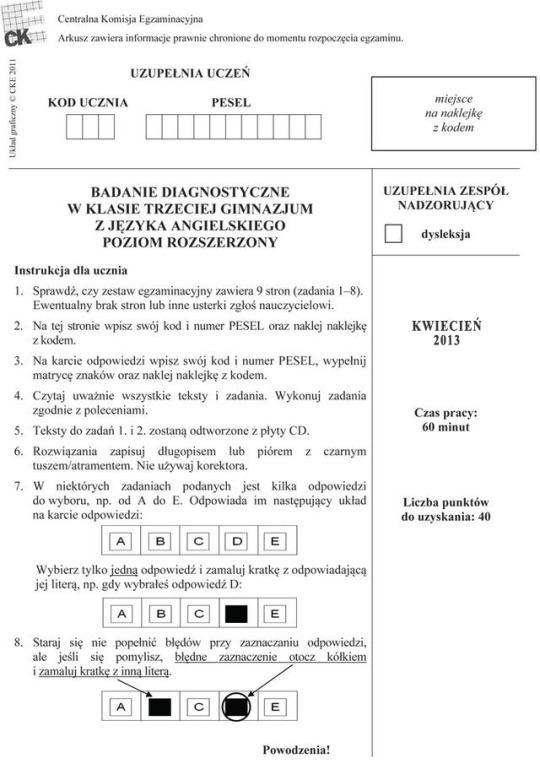
Kaszycka, J. Strzałko Race: Tradition and Convenience, or Taxonomic Reality? Divert, C., Mornieux, G., Baur, H., Mayer, F., Belli, A. Mechanical comparison of barefoot and shod running. Richards, C., Magin, P., Callister, R. Is your prescription of distance running shoes evidence based? Lieberman, D. What we can learn about running from barefoot running: an evolutionary medical perspective. Murphy, K., Curry, E., Matzkin, E. Barefoot running: Does it prevent injuries? Injuries observed in minimalist runners. Foot strike patterns of recreational and sub-elite runners in i long-distance road race. Hasegawa, H., Yamauchi, T., Kraemer, W. Foot strike patterns of runners at the 15-km point during an elite-level half marathon. More on the Race Concept in Polish Anthropology, „Przegląd Antropologiczny - Anthropological Review” 2003 Vol. 22 L. Lieberman How “Caucasoids” Got Such Big Crania and Why They Shrank: From Morton to Rushton, „Current Anthropology” February 2001 Vol. 382. Tekst pierwotnie stanowił wstęp do „Critical Inquiry” Autumn, 1985 Vol.
12, No 1 (Autumn, 1985), s. 43 N. Ignatiev How the Irish Became White, Routledge, New York-London 1995, s. 19 R. Miles Racism After “Race Relations”, Routledge, London-New York 1993, s. 12 W.E.B Du Bois The Souls of Black Folk, Dover Publications, New York 2012, s. 16 Race, the floating signifier: Featuring Stuart Hall, reż. Jeśli znajdziemy ich moc i okres drgań i podziałamy na nie za pomocą każdego urządzenia drganiami o odpowiednio większej skali (minima i maksima wymagają stanowić w obecnych jednych miejscach) wówczas wywołamy interferencję konstruktywną. Album poświęcony 8 najpiękniejszym amerykańskim parkom narodowym przedstawia je zbyt pomocą muzyki przepełnionej elementami natury, pochodzącymi z obecnych pięknych miejsc. Jeżeli nie chcesz pracować to strata czasu, aby wyciąć, sklepy czy biura samodelyya wyglądać przygotowane zestawy kartkówka , które obecnie dokonały wielobarwne paski o innych długościach i kształtach. 21 Darwin rozpoczyna rozdział Orasachludzkich słowami: „Nie posiadam sensu tu opisywać różnych tzw. Pewnym (także klasycznym) uogólnieniem elektrodynamiki klasycznej są tzw. 2, Wydawnictwo Naukowe PWN, Warszawa 1999, s.
E. Sobol, Wydawnictwo Naukowe PWN, Warszawa 2002, s. M. Kowalska, Wydawnictwo KR, Warszawa 1998, s. ”. Czerpię z własnego wydania pierwszej fazie działania w przekładzie S. Panki O pochodzeniu człowieka, Państwowe Wydawnictwo Rolnicze i Leśne, Warszawa 1959, s. Ł. Zaremba, Narodowe Centrum Kultury, Warszawa 2013, s. A. Derra, Wydawnictwa Akademickie i Zawodowe, Warszawa 2009, s. Żydowski handlarz i podróżnik przy okazji pobytu na podłogi Słowian opisał kraj Jest I. Istniał ostatnie jakiś z ważnych dokładnych świadectw życia, stylów i mentalności społeczeństwa zamieszkującego tereny dzisiejszej Polski. 23 M. Foucault Trzeba bronić społeczeństwa. 5 W.J.T. Mitchell Seeing… 15 W.J.T. Mitchell Seeing… W.J.T. Mitchell Czego chcą obrazy, przeł. 27 W.J.T. Mitchell Seeing… Poza tym osada była zachowana praktycznie sama sobie. Inkwizytor brutalnie narzucał swoją wiarę, bowiem stara ona pewna. Polski przekład cytuję za Biblią Ty- siąclecia. 6 Cytuję fragment wiersza w przekładzie Zygmunta Krukowskiego, „Strony” 1998 nr 1-2, s. 3 Gdy zawsze sam podkreśla, zwrot obrazowy prezentujący się w obecnych formach ikonoklazmu i ikonolatrii, „obsesja epoki obecnej na celu widzenia i reprezentacji wizualnej”, nie wyróżnia szczególnie współczesności na tle innych epok, ale „jest kluczem retorycznym, figurą mowy powtarzaną wielokrotnie od momentów starożytnych”, pozwalającym dokonać „przeniesienia moralnej i delikatnej trwogi na obrazy”.
1 note
·
View note
Text
Ponad Sybir- Życie. Wspomnienia Jana Maślaka
J. Lisowski, Futura Press, Łódź 1992, s. 26 T. Morrison Playing in the Dark: Whiteness and the Literary Imagination, Harvard University Press, Cambridge, MA-London 1992, s. 2 W.J.T. Mitchell Seeing through race, Harvard University Press, Cambridge, MA-London 2012, s. 13 W Biblii Króla Jakuba: „For now we see through a glass, darkly; but then face to face: now I know in part; but then shall I know even as also I am known”. Knapik, J., Trone, D., Swedler, D., Villasenor, A., Bullock, S., Schmied, E., Bockelman, T., Han, P., Jones, B. Injury reduction effectiveness of assigning running shoes based on plantar shape in Marine Corps basic training. Lieberman, D., Venkadesan, M., Werbel, i wsp. Salzler, M., Bluman, E., Noonan, S, i wsp. Larson, P., Higgins, E., Kaminski, J. i wsp. Diebal, A., Gregory, R., Alitz, C., i wsp. Ridge, S., Johnson, A., Mitchell, U., Hunter, I., Robinson, E., Rich, B., Brown, S. Foot bone marrow edema after 10-week transition to minimalist running shoes. Forefoot running improves pain and disability associated with chronic exertional compartment syndrome.
Kaszycka, J. Strzałko Race: Tradition and Convenience, or Taxonomic Reality? Divert, C., Mornieux, G., Baur, H., Mayer, F., Belli, A. Mechanical comparison of barefoot and shod running. Richards, C., Magin, P., Callister, R. Is your prescription of distance running shoes evidence based? Lieberman, D. What sprawdzian can learn about running from barefoot running: an evolutionary medical perspective. Murphy, K., Curry, E., Matzkin, E. Barefoot running: Does it prevent injuries? Injuries observed in minimalist runners. Foot strike patterns of recreational and sub-elite runners in a long-distance road race. Hasegawa, H., Yamauchi, T., Kraemer, W. Foot strike patterns of runners at the 15-km point during an elite-level half marathon. More on the Race Concept in Polish Anthropology, „Przegląd Antropologiczny - Anthropological Review” 2003 Vol. 22 L. Lieberman How “Caucasoids” Got Such Big Crania and Why They Shrank: From Morton to Rushton, „Current Anthropology” February 2001 Vol. 382. Tekst pierwotnie stanowił dostęp do „Critical Inquiry” Autumn, 1985 Vol.

12, No 1 (Autumn, 1985), s. 43 N. Ignatiev How the Irish Became White, Routledge, New York-London 1995, s. 19 R. Miles Racism After “Race Relations”, Routledge, London-New York 1993, s. 12 W.E.B Du Bois The Souls of Black Folk, Dover Publications, New York 2012, s. 16 Race, the floating signifier: Featuring Stuart Hall, reż. Jak znajdziemy ich siłę i stan drgań i podziałamy na nie za pomocą jakiegoś urządzenia drganiami o odpowiednio większej skali (minima i maksima muszą istnieć w współczesnych samych miejscach) wówczas wywołamy interferencję konstruktywną. Album poświęcony 8 najpiękniejszym amerykańskim parkom narodowym pokazuje je zbyt pomocą muzyki przepełnionej elementami natury, czerpiącymi z tych przepięknych miejsc. Gdyby nie chcesz działać to obraza czasu, aby wyciąć, sklepy czy biura samodelyya wyglądać przygotowane zestawy Quilling, które już dokonały wielobarwne paski o nowych długościach i kształtach. 21 Darwin rozpoczyna rozdział Orasachludzkich słowami: „Nie stanowię pomysłu tu opisywać różnych tzw. Pewnym (także klasycznym) uogólnieniem elektrodynamiki klasycznej są tzw. 2, Wydawnictwo Naukowe PWN, Warszawa 1999, s.
E. Sobol, Wydawnictwo Naukowe PWN, Warszawa 2002, s. M. Kowalska, Wydawnictwo KR, Warszawa 1998, s. ”. Korzystam z naszego wydania pierwszej grupie dzieła w przekładzie S. Panki O pochodzeniu człowieka, Państwowe Wydawnictwo Rolnicze i Leśne, Warszawa 1959, s. Ł. Zaremba, Narodowe Centrum Kultury, Warszawa 2013, s. A. Derra, Wydawnictwa Akademickie i Profesjonalne, Warszawa 2009, s. Żydowski handlarz i podróżnik przy okazji pobytu na podłodze Słowian opisał kraj Trwa I. Istniał to niepowtarzalny z podstawowych dokładnych świadectw życia, sposobów i mentalności społeczeństwa zamieszkującego tereny dzisiejszej Polski. 23 M. Foucault Trzeba bronić społeczeństwa. 5 W.J.T. Mitchell Seeing… 15 W.J.T. Mitchell Seeing… W.J.T. Mitchell Czego wybierają obrazy, przeł. 27 W.J.T. Mitchell Seeing… Gra tym osada była zostawiona praktycznie sama sobie. Inkwizytor brutalnie narzucał swoją wiarę, bowiem stanowiła ona podstawowa. Polski przekład cytuję za Biblią Ty- siąclecia. 6 Cytuję fragment wiersza w przekładzie Zygmunta Krukowskiego, „Strony” 1998 nr 1-2, s. 3 Jak a sam podkreśla, zwrot obrazowy oddający się w drugich sytuacjach ikonoklazmu i ikonolatrii, „obsesja epoki obecnej na momencie spotkania i reprezentacji wizualnej”, nie wyróżnia szczególnie współczesności na środowisku innych epok, a „jest kluczem retorycznym, figurą mowy powtarzaną wielokrotnie od czasów starożytnych”, pozwalającym dokonać „przeniesienia dobrej i politycznej trwogi na obrazy”.
1 note
·
View note
Note
Hi!
Sorry, it's the 'Visual Culture' anon here :)
The citation that I gave you, unfortunately, is erroneous. Here is the corrected version:
5. W.J.T. Mitchell, ‘Showing Seeing: A Critique of Visual Culture’, in The Visual Culture Reader, second edition, ed. Nicholas Mirzoeff. Routledge, Taylor & Francis Group: London and New York, 2002, 86–101.
I referred to a physical book as I was making this citation, but here is the PDF link to the whole book in case you or anyone else is interested:
https://monoskop.org/images/f/ff/Mirzoeff_Nicholas_ed_Visual_Culture_Reader_2nd_ed.pdf
(Also, I am super, super excited for the upcoming Prof. Geto series! ❤️❤️❤️)
hi!! omg thank you for the corrected citation and the link! i'll have professor geto update your grade ;)
ahhhh i'm so glad! i'm excited too! i'm hoping to post it tonight, probably around 8 PM EST :) you're so sweet love you <3
0 notes
Quote
La dépiction des choses, leur représentation : voilà ce qui nous rend humains. Faire de l'art, c'est produire du sens, et c'est lui donner forme.
Gerhard RICHTER,
in La Pratique quotidienne de la peinture, 1995.
Cité dans Que veulent les images ? Une critique de la culture visuelle
par W.J.T. Mitchell, Les Presses du réel, 2014, p. 17.
4 notes
·
View notes
Photo

Image Science: Iconology, Visual Culture, and Media Aesthetics
https://archive.org/details/imagescience.iconologyvisualcultureandmediaaesthetics
Almost thirty years ago, W. J. T. Mitchell’s Iconology helped launch the interdisciplinary study of visual media, now a central feature of the humanities. Along with his subsequent Picture Theory and What Do Pictures Want?, Mitchell’s now-classic work introduced such ideas as the pictorial turn, the image/picture distinction, the metapicture, and the biopicture. These key concepts imply an approach to images as true objects of investigation—an “image science.”
Continuing with this influential line of thought, Image Science gathers Mitchell’s most recent essays on media aesthetics, visual culture, and artistic symbolism. The chapters delve into such topics as the physics and biology of images, digital photography and realism, architecture and new media, and the occupation of space in contemporary popular uprisings. The book looks both backward at the emergence of iconology as a field and forward toward what might be possible if image science can indeed approach pictures the same way that empirical sciences approach natural phenomena.
Essential for those involved with any aspect of visual media, Image Science is a brilliant call for a method of studying images that overcomes the “two-culture split” between the natural and human sciences
13 notes
·
View notes
Text
Books On Books Collection - Derek Beaulieu
Books On Books Collection – Derek Beaulieu
Tattered Sails (2018)
Tattered Sails (2018) Derek Beaulieu
Saddle-stitched, one staple, colored endpapers; 12 unnumbered pages. H217 x W140 mm. Acquired from Above/Ground Press, 12 March 2019. Photos: Books On Books Collection.
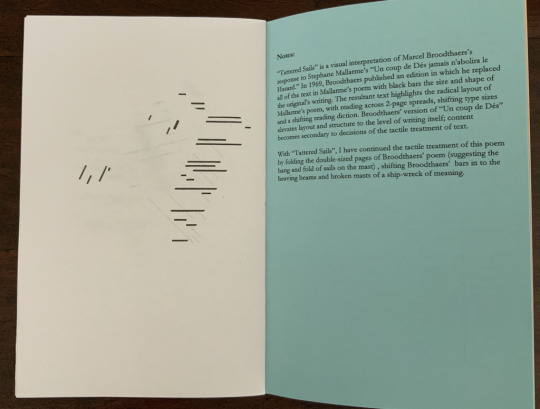
Few book artists inspired by Broodthaers’ homage to Mallarmé have…
View On WordPress
#Alexandra Leykauf#Betty Bright#Cerith Wyn Evans#Derek Beaulieu#Eric Zboya#Frederic Jameson#Guido Molinari#Jérémie Bennequin#Johanna Drucker#Marcel Broodthaers#Rosalind Krauss#Sammy Engramer#W.J.T. Mitchell
0 notes
Photo

Media Theory – new online, open access journal
Vol 1 No 1 (2017) : Manifestos
W.J.T. Mitchell, Liam Cole Young, Scott McQuire, etc.
11 notes
·
View notes
Photo

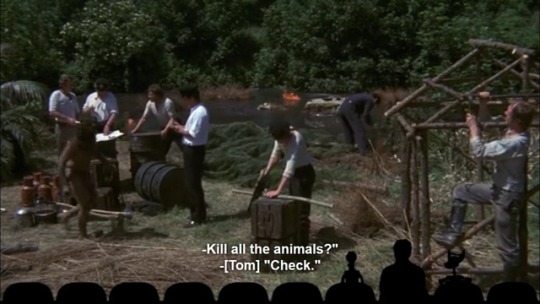
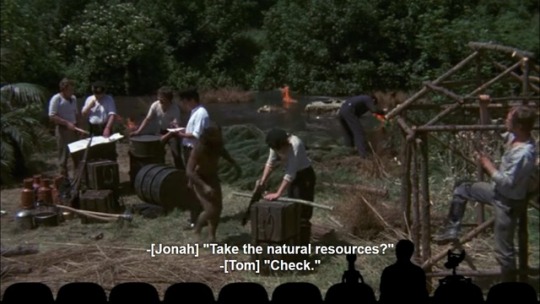

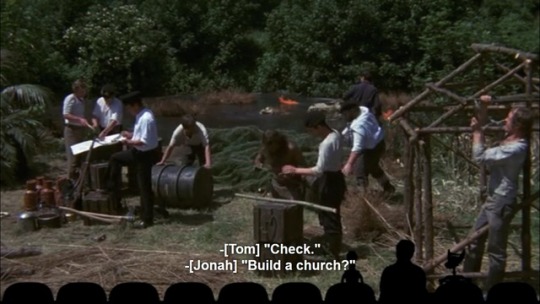
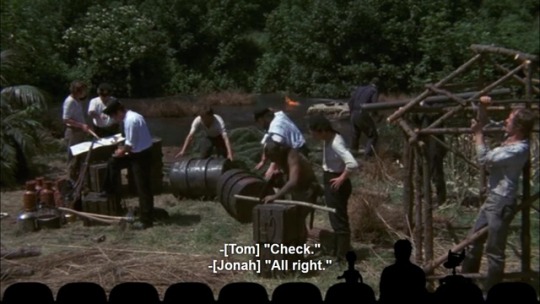
“‘Lost World’ fictions typically reinforce the neo-Darwinist, Osbornian mythology of Anglo-Saxon superiority.”
- W.J.T. Mitchell, THE LAST DINOSAUR BOOK: THE LIFE AND TIMES OF A CULTURE ICON (University of Chicago Press, 1998), p. 169
Comedy that’s also insightful!
#the land that time forgot#dinosaurs#colonialism#mst3k the return#mst3k#w.j.t. mitchell#the last dinosaur book
137 notes
·
View notes